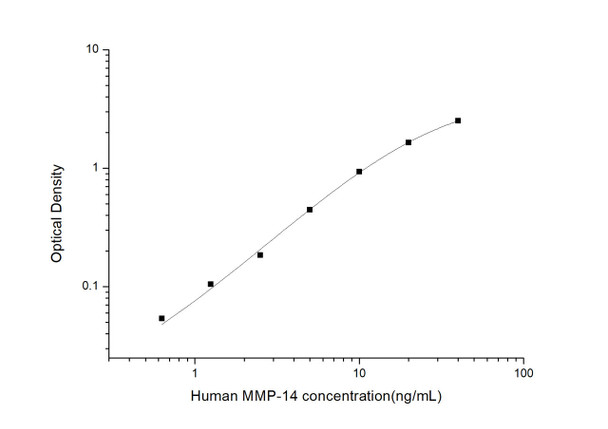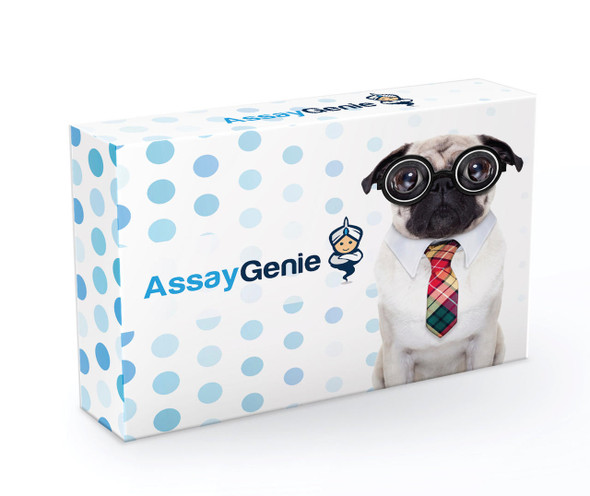Human Cell Biology ELISA Kits 1
Human MMP-14 (Matrix Metalloproteinase 14) ELISA Kit (HUES03318)
- SKU:
- HUES03318
- Product Type:
- ELISA Kit
- Size:
- 96 Assays
- Uniprot:
- P50281
- Sensitivity:
- 0.38ng/mL
- Range:
- 0.63-40ng/mL
- ELISA Type:
- Sandwich
- Synonyms:
- MMP14, MMP-X1, MT1-MMP, MT1MMP, MTMMP1
- Reactivity:
- Human
- Sample Type:
- Serum, plasma and other biological fluids
- Research Area:
- Cell Biology
Description
| Assay type: | Sandwich |
| Format: | 96T |
| Assay time: | 4.5h |
| Reactivity: | Human |
| Detection Method: | Colormetric |
| Detection Range: | 0.63-40 ng/mL |
| Sensitivity: | 0.38 ng/mL |
| Sample Volume Required Per Well: | 100µL |
| Sample Type: | Serum, plasma and other biological fluids |
| Specificity: | This kit recognizes Human MMP-14 in samples. No significant cross-reactivity or interference between Human MMP-14 and analogues was observed. |
This ELISA kit uses Sandwich-ELISA as the method. The micro ELISA plate provided in this kit has been pre-coated with an antibody specific to Human MMP-14. Standards or samples are added to the appropriate micro ELISA plate wells and combined with the specific antibody. Then a biotinylated detection antibody specific for Human MMP-14 and Avidin-Horseradish Peroxidase (HRP) conjugate are added to each micro plate well successively and incubated. Free components are washed away. The substrate solution is added to each well. Only those wells that contain Human MMP-14, biotinylated detection antibody and Avidin-HRP conjugate will appear blue in color. The enzyme-substrate reaction is terminated by adding Stop Solution and the color turns yellow. The optical density (OD) is measured spectrophotometrically at a wavelength of 450 nm ± 2 nm. The OD value is proportional to the concentration of Human MMP-14. The concentration of Human MMP-14 in samples can be calculated by comparing the OD of the samples to the standard curve.
| UniProt Protein Function: | MMP14: Seems to specifically activate progelatinase A. May thus trigger invasion by tumor cells by activating progelatinase A on the tumor cell surface. May be involved in actin cytoskeleton reorganization by cleaving PTK7. Up-regulated by NANOS1. Expressed in stromal cells of colon, breast, and head and neck. Expressed in lung tumors. Belongs to the peptidase M10A family. |
| UniProt Protein Details: | Protein type:EC 3. 4. 24. 80; Protease; Motility/polarity/chemotaxis; Membrane protein, integral Chromosomal Location of Human Ortholog: 14q11. 2 Cellular Component: extracellular matrix; focal adhesion; Golgi lumen; integral to plasma membrane; cytoplasm; melanosome; plasma membrane Molecular Function:integrin binding; protein binding; protease activator activity; zinc ion binding; metalloendopeptidase activity; calcium ion binding; transcription factor activity Biological Process: extracellular matrix organization and biogenesis; tissue remodeling; negative regulation of focal adhesion formation; male gonad development; embryonic cranial skeleton morphogenesis; proteolysis; positive regulation of cell growth; collagen catabolic process; extracellular matrix disassembly; regulation of transcription, DNA-dependent; branching morphogenesis of a tube; ovarian follicle development; response to estrogen stimulus; response to mechanical stimulus; endothelial cell proliferation; response to hypoxia; zymogen activation; response to oxidative stress; angiogenesis; astrocyte cell migration; lung development; positive regulation of cell migration; endochondral ossification Disease: Winchester Syndrome |
| NCBI Summary: | Proteins of the matrix metalloproteinase (MMP) family are involved in the breakdown of extracellular matrix in normal physiological processes, such as embryonic development, reproduction, and tissue remodeling, as well as in disease processes, such as arthritis and metastasis. Most MMP's are secreted as inactive proproteins which are activated when cleaved by extracellular proteinases. However, the protein encoded by this gene is a member of the membrane-type MMP (MT-MMP) subfamily; each member of this subfamily contains a potential transmembrane domain suggesting that these proteins are expressed at the cell surface rather than secreted. This protein activates MMP2 protein, and this activity may be involved in tumor invasion. [provided by RefSeq, Jul 2008] |
| UniProt Code: | P50281 |
| NCBI GenInfo Identifier: | 317373419 |
| NCBI Gene ID: | 4323 |
| NCBI Accession: | P50281. 3 |
| UniProt Secondary Accession: | P50281,Q6GSF3, Q92678, A8K5L0, |
| UniProt Related Accession: | P50281 |
| Molecular Weight: | 65,894 Da |
| NCBI Full Name: | Matrix metalloproteinase-14 |
| NCBI Synonym Full Names: | matrix metallopeptidase 14 (membrane-inserted) |
| NCBI Official Symbol: | MMP14 |
| NCBI Official Synonym Symbols: | MMP-14; MMP-X1; MT-MMP; MT1MMP; MTMMP1; WNCHRS; MT1-MMP; MT-MMP 1 |
| NCBI Protein Information: | matrix metalloproteinase-14; membrane type 1 metalloprotease; membrane-type-1 matrix metalloproteinase |
| UniProt Protein Name: | Matrix metalloproteinase-14 |
| UniProt Synonym Protein Names: | MMP-X1; Membrane-type matrix metalloproteinase 1; MT-MMP 1; MTMMP1; Membrane-type-1 matrix metalloproteinase; MT1-MMP; MT1MMP |
| Protein Family: | Matrix metalloproteinase |
| UniProt Gene Name: | MMP14 |
| UniProt Entry Name: | MMP14_HUMAN |
As the OD values of the standard curve may vary according to the conditions of the actual assay performance (e. g. operator, pipetting technique, washing technique or temperature effects), the operator should establish a standard curve for each test. Typical standard curve and data is provided below for reference only.
| Concentration (ng/mL) | O.D | Average | Corrected |
| 40 | 2.562 2.6 | 2.581 | 2.505 |
| 20 | 1.698 1.736 | 1.717 | 1.641 |
| 10 | 1.013 1.005 | 1.009 | 0.933 |
| 5 | 0.505 0.539 | 0.522 | 0.446 |
| 2.5 | 0.268 0.254 | 0.261 | 0.185 |
| 1.25 | 0.187 0.175 | 0.181 | 0.105 |
| 0.63 | 0.129 0.131 | 0.13 | 0.054 |
| 0 | 0.067 0.085 | 0.076 | -- |
Precision
Intra-assay Precision (Precision within an assay): 3 samples with low, mid range and high level Human MMP-14 were tested 20 times on one plate, respectively.
Inter-assay Precision (Precision between assays): 3 samples with low, mid range and high level Human MMP-14 were tested on 3 different plates, 20 replicates in each plate.
| Intra-assay Precision | Inter-assay Precision | |||||
| Sample | 1 | 2 | 3 | 1 | 2 | 3 |
| n | 20 | 20 | 20 | 20 | 20 | 20 |
| Mean (ng/mL) | 2.15 | 6.12 | 17.04 | 2.36 | 6.21 | 18.28 |
| Standard deviation | 0.14 | 0.34 | 0.78 | 0.12 | 0.33 | 0.67 |
| C V (%) | 6.51 | 5.56 | 4.58 | 5.08 | 5.31 | 3.67 |
Recovery
The recovery of Human MMP-14 spiked at three different levels in samples throughout the range of the assay was evaluated in various matrices.
| Sample Type | Range (%) | Average Recovery (%) |
| Serum (n=5) | 89-102 | 95 |
| EDTA plasma (n=5) | 85-98 | 92 |
| Cell culture media (n=5) | 86-100 | 91 |
Linearity
Samples were spiked with high concentrations of Human MMP-14 and diluted with Reference Standard & Sample Diluent to produce samples with values within the range of the assay.
| Serum (n=5) | EDTA plasma (n=5) | Cell culture media (n=5) | ||
| 1:2 | Range (%) | 93-106 | 94-108 | 98-113 |
| Average (%) | 99 | 101 | 105 | |
| 1:4 | Range (%) | 88-102 | 84-97 | 81-94 |
| Average (%) | 95 | 89 | 88 | |
| 1:8 | Range (%) | 93-107 | 80-92 | 86-99 |
| Average (%) | 98 | 86 | 92 | |
| 1:16 | Range (%) | 91-105 | 84-94 | 86-99 |
| Average (%) | 97 | 88 | 92 |
An unopened kit can be stored at 4°C for 1 month. If the kit is not used within 1 month, store the items separately according to the following conditions once the kit is received.
| Item | Specifications | Storage |
| Micro ELISA Plate(Dismountable) | 8 wells ×12 strips | -20°C, 6 months |
| Reference Standard | 2 vials | |
| Concentrated Biotinylated Detection Ab (100×) | 1 vial, 120 µL | |
| Concentrated HRP Conjugate (100×) | 1 vial, 120 µL | -20°C(shading light), 6 months |
| Reference Standard & Sample Diluent | 1 vial, 20 mL | 4°C, 6 months |
| Biotinylated Detection Ab Diluent | 1 vial, 14 mL | |
| HRP Conjugate Diluent | 1 vial, 14 mL | |
| Concentrated Wash Buffer (25×) | 1 vial, 30 mL | |
| Substrate Reagent | 1 vial, 10 mL | 4°C(shading light) |
| Stop Solution | 1 vial, 10 mL | 4°C |
| Plate Sealer | 5 pieces | |
| Product Description | 1 copy | |
| Certificate of Analysis | 1 copy |
- Set standard, test sample and control (zero) wells on the pre-coated plate and record theirpositions. It is recommended to measure each standard and sample in duplicate. Note: addall solutions to the bottom of the plate wells while avoiding contact with the well walls. Ensuresolutions do not foam when adding to the wells.
- Aliquot 100µl of standard solutions into the standard wells.
- Add 100µl of Sample / Standard dilution buffer into the control (zero) well.
- Add 100µl of properly diluted sample (serum, plasma, tissue homogenates and otherbiological fluids) into test sample wells.
- Cover the plate with the sealer provided in the kit and incubate for 90 min at 37°C.
- Aspirate the liquid from each well, do not wash. Immediately add 100µL of BiotinylatedDetection Ab working solution to each well. Cover the plate with a plate seal and gently mix. Incubate for 1 hour at 37°C.
- Aspirate or decant the solution from the plate and add 350µL of wash buffer to each welland incubate for 1-2 minutes at room temperature. Aspirate the solution from each well andclap the plate on absorbent filter paper to dry. Repeat this process 3 times. Note: a microplatewasher can be used in this step and other wash steps.
- Add 100µL of HRP Conjugate working solution to each well. Cover with a plate seal andincubate for 30 min at 37°C.
- Aspirate or decant the solution from each well. Repeat the wash process for five times asconducted in step 7.
- Add 90µL of Substrate Reagent to each well. Cover with a new plate seal and incubate forapproximately 15 min at 37°C. Protect the plate from light. Note: the reaction time can beshortened or extended according to the actual color change, but not by more than 30min.
- Add 50 µL of Stop Solution to each well. Note: Adding the stop solution should be done inthe same order as the substrate solution.
- Determine the optical density (OD value) of each well immediately with a microplate readerset at 450 nm.






